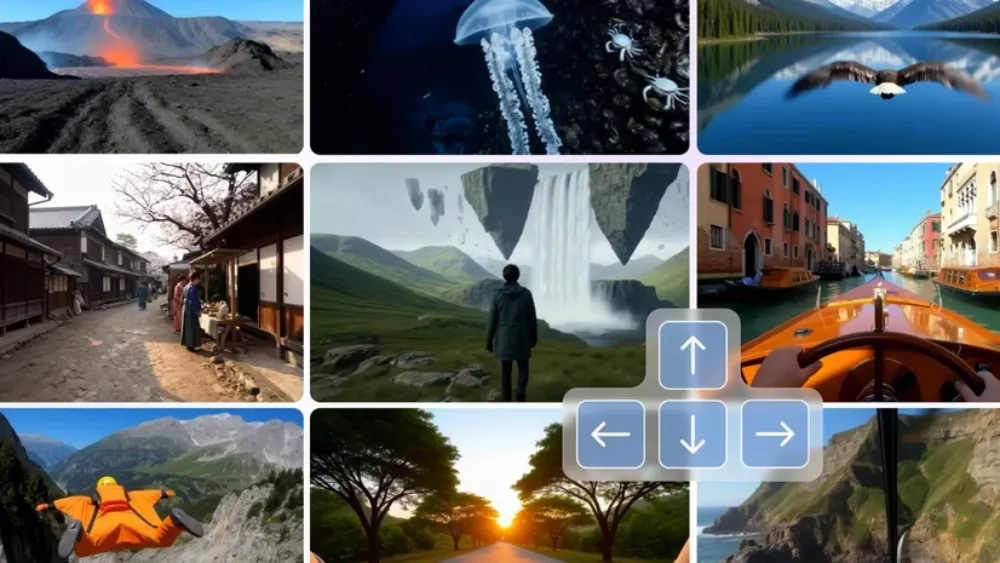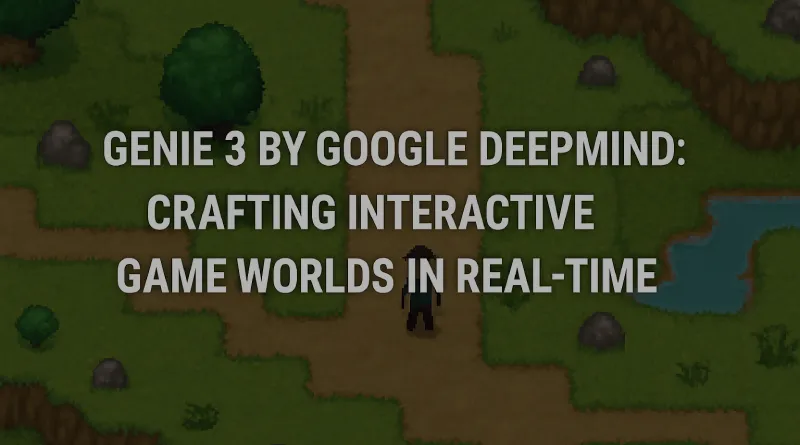Genie 3 by Google DeepMind: Crafting Interactive Game Worlds in Real-Time
Google DeepMind has demonstrated Genie 3, a world model that uses artificial intelligence to quickly turn textual guidance into interesting, interactive 3D scenes, a key advance for artificial intelligence. Released on August 6, 2025, Genie 3 creates dynamic 720p (visual) worlds at 24 frames per second, with enough visual consistency to keep players going through several minutes-far beyond its predecessor, Genie 2, which could only keep players entertained with 10-20 seconds of gameplay. The Economic Times touts this breakthrough as opening up a new frontier in the areas of gaming, robotics and education with significant ramifications across the Indian tech industry, where the AI market is estimated to grow to 7.8 billion by 2025 (NASSCOM).
A New Era of Interactive Simulation
Genie 3 gives users an opportunity to navigate through virtual worlds, by merely entering a prompt-think of strolling through the busy markets of Delhi or in a calm village in the Himalayas. It has the capability to remember things, even a painted wall or written text, after it has been navigated due to a long-lasting visual memory of up to a minute, which is a discovery that occurred organically during its training as explained by Free Press Journal. Any users can dynamically modify such worlds in the middle of exploration, such as by changing weather, inserting characters, or rearranging landscape, through text commands, thus it is a useful tool of real time creativity.
Genie 3 was developed based on the ten-year exploration which DeepMind has done on the simulated platforms, and it encompasses the developments in the model, such as Veo 3, which is characterized by the intuitive nature of physics and the visual coherence. Beyond games, its flexibility and performance provide benefits to other applications such as training artificial intelligence agents like SIMA to perform multi-task in a wide variety of complex environments, like virtual warehouses, with no pre-determined goals, a step towards achieving artificial general intelligence (AGI).

Technical Strengths and Limitations
The model’s frame-by-frame generation, without reliance on advanced techniques like NeRFs or Gaussian Splatting, showcases its robustness. It simulates natural phenomena (e.g., water flow, lighting) and fictional scenarios with impressive fidelity, though physical accuracy, such as snow behavior, improves with specific prompts. Current limitations include restricted agent-initiated actions, nascent multi-agent interactions, and a cap of a few minutes per session, though DeepMind is refining these aspects.
Local Context and Opportunities in India
With 900 million smartphone owners (Statista, 2025) and a gaming market worth 2.6 billion dollars (IBEF, 2024), India will be greatly favored by the trend. Genie 3 could be used in interactive game development or as a virtual training platform by its local tech hub in Bengaluru, which is home to 40 percent of India AI startups (Tracxn, 2024). In education, where 300 million students strain with lack of resources (UNESCO, 2024) it may substitute historical simulations, or science experiments, particularly in rural areas, where 3 out of 10 lack internet (NITI Aayog, 2024). It may also be utilized by robotics companies in Pune that constitute a part of a $3 billion market (FICCI, 2024) to train autonomous systems safely.
Unique Insights and Global Relevance
The lesson here is that Genie 3 managed to emerge more consistent, which provides a roadmap of unsupervised learning that Indian scientists can take to low-cost AI training, as 70 percent of the technology is imported into the country (MeitY, 2024). It competes with models such as the Muse created by Microsoft that generated the sequences of Quake II although the real-time interactivity enabled by Genie 3 makes a difference globally. Enthusiastic X users such as @TechIndiaAI praise its potential but worry of its misuse is met with ethical concerns over making deceptive reality.
Practical Applications Across Industries
To a gamer it would mean infinite world generation-A Mughal fort or a futuristic Mumbai at the touch of a command. It offers unlimited training scenarios in the field of robotics and lowers the risk involved in the real world. By prototyping virtual structures, production will be reduced by 20 percent in the creative industries of Bollywood in Mumbai (FICCI, 2024). Teachers would be able to create interactive history classes that would allow increasing engagement by 30 percent (EdTech India, 2024). But there are hardware requirements (sturdy GPUs) and local data requirements, an issue that means 60 percent of the Indian AI models were biased towards the westerners (NASSCOM, 2024).
Getting Started and Safety Measures
Under a closed research preview, Genie 3 is available to other scholars and developers through DeepMind and accepting applications are credible use cases. The reserved deployment strategy used by DeepMind, which restricts text generation to targeted prompts, mitigates safety concerns, and all access would become available in 2026 subject to feedback. This also falls in line with the Indian 2026 AI governance framework (MeitY), which focuses on ethical usage of AI.
Broader Impact and Future Prospects
The release of Genie 3 is sharing the Silicon Valley headlines with the world, such as Palantir with a $1billion quarter (Economic Times, August 2025), indicating ramping levels of AI investment. Conversely, natural phenomena such as the 8.8 magnitude Kamchatka earthquake (Economic Times, July 30, 2025) that shifted the peninsula by two meters also demonstrates the importance of well-developed simulation tools in the process of examining the geophysical effects that could be another application of Genie 3. Subsequent versions could last longer and further develop multi-agent interaction, and in the future, they could be combined with the digital infrastructure of India to connect urban-rural gaps.
Conclusion
Google DeepMind Genie 3 changes the definition of interactive AI and provides a playground to be creative. In the case of India, it entails an opportunity to dominate simulation technology, yet the quality of success would consequently depend on solving infrastructural limitations, ethical dangers, and localization. Due to the further optimization in this model, DeepMind will have the potential to revolutionize our play, learn and build as the space between the real and the virtual is closing.
Disclaimer
The information presented in this blog is derived from publicly available sources for general use, including any cited references. While we strive to mention credible sources whenever possible, Web Techneeq – Website Developer in Mumbai does not guarantee the accuracy of the information provided in any way. This article is intended solely for general informational purposes. It should be understood that it does not constitute legal advice and does not aim to serve as such. If any individual(s) make decisions based on the information in this article without verifying the facts, we explicitly reject any liability that may arise as a result. We recommend that readers seek separate guidance regarding any specific information provided here.

